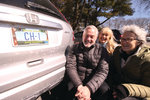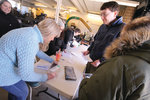By JOHN HOWELL
As of Saturday, there are a lot more critters on Rhode Island highways. But you needn’t fear running them over.
The animals native to Rhode Island adorn the new Rhode Island …
This item is available in full to subscribers.
We have recently launched a new and improved website. To continue reading, you will need to either log into your subscriber account, or purchase a new subscription.
If you are a current print subscriber, you can set up a free website account by clicking here.
Otherwise, click here to view your options for subscribing.
Please log in to continue |
|


By JOHN HOWELL
As of Saturday, there are a lot more critters on Rhode Island highways. But you needn’t fear running them over.
The animals native to Rhode Island adorn the new Rhode Island Save Wildlife license plate, which was distributed to more than 600 people who had pre-ordered the plate since the Wildlife Rehabilitators Association of Rhode Island launched its drive about nine years ago.
Initially, the organization was faced with obtaining 900 pre-sales in order for the plates to be issued. However, the goal came within reach when the General Assembly reduced the threshold to 600 last year, said Arianna Mouradijan, one of the staff members who operate the Wildlife Clinic of Rhode Island in North Kingstown.
Plates were issued from the former Lloyd Cooper Armory on Sandy Lane in Warwick. A steady stream of vehicles pulled in and out of the lot as vehicle owners traded their old plates – most of them the Rhode Island wave – for the Save Wildlife plate framed by a squirrel, raccoon, fox, owl and deer. The plate is the creation of Dr. Meredith Bird, a member of the board of WRARI.
The plates cost $40, with half the money going to support the WRARI. In the course of a year, the group helps between 4,000 and 5,000 injured, sick or orphaned wild animals.
The animals assisted are basically divided between mammals, with squirrels and rabbits being the preponderance along with birds – although reptiles, especially turtles, are showing up more frequently, says Dr. Lucy Spelman, chair of the board. She believes there is a growing awareness of wildlife and people take a personal interest when they find an injured or orphaned animal.
“When you find an injured animal, it can be really upsetting,” Spelman said. She is one of 165 veterinarians worldwide board-certified in zoological medicine.
“We want people to do the right thing,” she said, emphasizing people who find an injured animal should call the Wildlife Hotline at 401-294-6363 and the Rhode Island Department of Environmental Management’s Division of Law Enforcement at 401-222-3070.
She said veterinarians across the state take in injured and orphaned wild animals that are then transported to the clinic. Not all of them are treated, nor is it necessarily in the animal’s best interest that they are. She gave the example of an eagle with a broken wing. A splint was used the hold the wing in place during recovery and the eagle was later released into the wild to fly again. But that procedure can’t be used for small birds.
“They’re not going to have a normal life,” she said.
In cases where it becomes apparent that the animal won’t survive in its natural habitat, it is euthanized. Orphaned baby animals often come with unique challenges. Apart from knowing what to feed them, there is difficultly in terms of when to feed them. Baby rabbits need to be fed every two hours. That’s something that happens at the WRARI clinic. That takes a dedicated staff augmented by equally dedicated volunteers. The bottom line is that it takes money.
Spelman knows that animals are compelling. The orphaned baby, whether a rabbit, raccoon or squirrel, or the injured animal makes for the ideal poster child in a campaign to raise funds and recruit volunteers. But the clinic is not a zoo where people can see the animals under care and follow their progress to the point where they are released into the wild. It is purposely off limits to visitors, as that would impair efforts to repatriate the animals into the wild.
Ideally, Spelman is looking for WRARI to double its $180,000 budget and attain its goal of acquiring the clinic it now leases.
She sees the license plates as raising awareness and contributing to the group’s fundraising efforts. And while a license plate may seem a long way from the wild, she hopes it serves as a connection between our daily lives and the space we all share with other animals.
Comments
No comments on this item Please log in to comment by clicking here